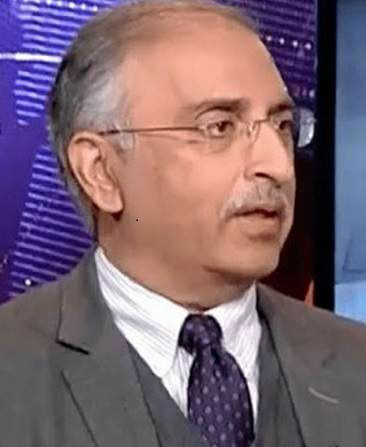Dr Farrukh Saleem
WE ARE sitting on a time bomb. The bomb is ticking. When will it explode? In 1970, every man, woman and child in this country was indebted to the tune of Rs500. In 2008, PPP came to power and took the per capita debt to Rs36,000.
In 2013, PML-N came to power and took the per capita debt to Rs88,000, In 2018, PTI came to power-and in 31 months-every man, woman and child in this country is now indebted to the tune of 200,000. Imagine; from Rs500 to Rs200,000 in a matter of 51 years.
Where will it end? In 2005, under President Musharraf the ‘Fiscal Responsibility and Debt Limitations Act’ was passed.
Under the law, the debt-to-GDP ratio was to be brought down to 60 percent within two financial years and then to 50 percent of GDP within five financial years.
Under President Zardari (2008-2103), our debt-to-GDP ratio hovered around 66 percent.
Under Prime Minister Nawaz Sharif (2013-2017), we took on additional debt and the debt-to-GDP ratio deteriorated to 73 percent.
Lo and behold, under Prime Minister Imran Khan (2018-2021), for the first time in our checkered financial history, the debt-to-GDP ratio has gone to 107 percent.
To be certain, the ‘Fiscal Responsibility and Debt Limitations Act’ is still in force. Where will it all end? When would the ‘debt bomb’ explode.
Under President Zardari (2008-2103), we were taking on additional debt of Rs5 billion a day, every day of the year for five years.
Under Prime Minister Nawaz Sharif (2013-2017), we were taking on additional debt of Rs8 billion a day, every day of the year for four years. Lo and behold, under Prime Minister Imran Khan (2018-2021), for the first time in our checkered financial history, we have been taking on additional debt of Rs18 billion a day, every day of the month for the past 31 months.
Under President Zardari (2008-2103), Pakistan’s external debt grew from $50 billion to $58 billion.
Under PML-N (2013-2018), Pakistan’s external debt grew from $58 billion to $93 billion.
Lo and behold, under Prime Minister Imran Khan (2018-2021),
Pakistan’s external debt has risen from $93 billion to over $115 billion in 31 months.
Where is all this debt going? Who is really swallowing this mountain of debt? Well, the PTI government over the past 31 months-as per its own records-has incurred an accumulated budget deficit of Rs10 trillion.
Plus, the PTI government over the past 31 months-as per its own records-has incurred an accumulated current account deficit [equivalent] of Rs4 trillion.
Off-the-budget, capacity payments in the electricity sector have amounted to Rs1.5 trillion. Off-the-budget, circular debt has
gone from Rs1.1 trillion to Rs2.4 trillion.
Off-the-budget, losses at State Owned Enterprises (SOEs) have amounted to Rs1.4 trillion. And, off-the-budget, loans under ‘commodity operations’ now stand at Rs750 billion.
Debt to Pakistan comes at a very high cost. Pakistan’s borrowing binge comes at a very high cost. Yes, the cost is usually hidden and often implicit.
Pakistan becomes a pawn in the lender’s strategic agenda. Pakistan has to cede control over her strategic assets-mineral resources and ports.
Pakistan would have to exchange her strategic resources in return for easy cash. Pakistan would be forced into giving strategic concessions.
That’s what ‘debt-trap diplomacy’ is all about. That’s ‘debt servitude’ in action.
When would our debt burden really become untenable? Compound interest is awfully powerful because compound interest results in exponential growth.
In 2018, when the PTI formed the government, we paid out 39 percent of total FBR taxes for servicing our debt.
Today, we must allocate a wholesome 74 percent of total FBR taxes towards debt servicing.
Red alert: By 2025, four years from now, 100 percent of FBR taxes would go towards debt servicing.
By 2025, we will have no money for the defense budget or the money to run the civil government. That’s when the debt-bomb would explode.
To be certain, the government can actually keep the debt-bomb from exploding by changing its course.
Cut down the Rs10 trillion accumulated budget deficit. Change the course in the debt-laden electricity sector which is creating a trillion rupee additional debt a year, every year.
In the electricity sector, the ‘single buyer model’ where the government is the lone buyer has completely flopped.
The government needs to create a ‘competitive model’ whereby there are multiple buyers in the private sector who can negotiate and buy directly from the generators of electricity.
Next SOEs; there is no way out but to cut the trillion-rupee loss at State Owned Enterprises.
The government has two choices: privatize or restructure. Almost all successful privatisation models have two preconditions: a transparent process of
privatization and an appropriate regulatory apparatus.
If our government prefers resutructing then the very first step would be to implement our very own Public Sector Companies (Corporate Governance) Rules, 2013.
These Rules provide explicit
guidelines on the formation of the ‘Board’, selection of the CEO and the appointment of ‘Independent Directors’.
What’s needed are three things: government intention to change course plus government capacity to change course plus political stability.
To be sure, intention alone won’t do it-and political instability won’t let a course correction take place.
Someone intelligent once said, “Modern slaves are not in chains; they are in debt”.










